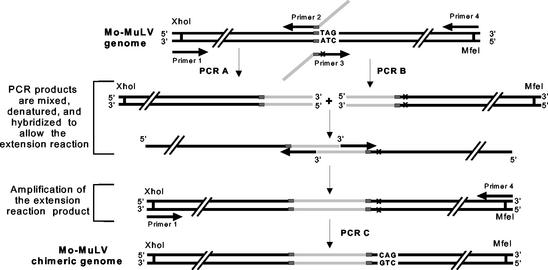FIG. 1.
Construction of chimeric virus sequence. The PCR strategy used to introduce the HIV-1 frameshift signal at the junction of gag and pol in Mo-MuLV is schematized. The Mo-MuLV sequence is represented by black lines, and the HIV-1 sequence is represented by light gray lines. Gray boxes represent the sequence of the cleavage site recognized by the viral protease. The target sequence of Mo-MuLV, where the HIV-1 frameshift was inserted, was flanked by restriction sites XhoI, in 5′, and MfeI, in 3′. The X symbol, in primer 3, indicates the single mutation (T→C) that replaced the gag stop codon (TAG) with a glutamine codon (CAG). The sequence to insert was encompassed in primers 2 and 3 and included in two separate PCR products, the 3′-end sequence of the PCR A product overlapping with the 5′-end sequence of PCR B product. The two PCR products were mixed and denatured, allowing one strand from each fragment to act as a primer on the other fragment. The new DNA product resulting from this extension reaction was then amplified in a third PCR (PCR C) using primers 1 and 4. The final PCR product was then digested with XhoI and MfeI and inserted into pGMo.

